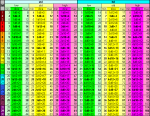Instigated by the first few excerpts from MM3 and the forthcoming Dark Sun Creature Collection I recently decided to investigate the damage progression tables given in the monster creation guidelines in the DMG.
Now, instinctually, like many others I've always felt that monster damage might actually be a bit too low, especially at the higher levels. But now I actually tried to make some sense of the numbers by calculating a couple of reference values.
I made a couple of assumptions that reflected my goal of making combat at higher levels about as dangerous as it is at level 1:
- use the average damage value for the normal moderate damage expression as a starting point
- brutes should represent the same threat as other monster roles, or more specifically skirmishers, which are as close to being a 'standard' monster as you can get
- damage should be compared against the hit points of player characters of the same level resulting the same percentage of hp lost
- one-hit kills should be impossible, so max damage should not exceed 1.5 times the lowest hp for a pc
After picking the original table apart I also decided on the following:
- damage should increase by an identical factor from column to column
The final adjustment I made was to apply a sliding balancing factor to compensate for the increased to-hit percentage in paragon/epic tier that is apparent when comparing average defenses with attack bonuses.
I also investigated the expected damage output of a standard party created using PHB1 material only (wizard, fighter, cleric, rogue, ranger) to compare it against monster hit points to decide if the values should also be adjusted to take longer staying power of monsters into account.
However, even before taking feats, magic item powers, action points, epic destiny traits, and critical hits into account, average damage output was sufficiently high at all levels to take monsters out in about six rounds (based on four encounters per day against five standard monsters of the same level).
So here's the resulting new damage progression table.
This is actually my first (intentional) visit to this forum. I assume someone else has already created something similar - probably a long time ago. So, I'd appreciate any pointers to previous efforts to revise the damage expression table!
For the sake of comparison, here's the original table from the DMG formatted similarly:
Now, instinctually, like many others I've always felt that monster damage might actually be a bit too low, especially at the higher levels. But now I actually tried to make some sense of the numbers by calculating a couple of reference values.
I made a couple of assumptions that reflected my goal of making combat at higher levels about as dangerous as it is at level 1:
- use the average damage value for the normal moderate damage expression as a starting point
- brutes should represent the same threat as other monster roles, or more specifically skirmishers, which are as close to being a 'standard' monster as you can get
- damage should be compared against the hit points of player characters of the same level resulting the same percentage of hp lost
- one-hit kills should be impossible, so max damage should not exceed 1.5 times the lowest hp for a pc
After picking the original table apart I also decided on the following:
- damage should increase by an identical factor from column to column
The final adjustment I made was to apply a sliding balancing factor to compensate for the increased to-hit percentage in paragon/epic tier that is apparent when comparing average defenses with attack bonuses.
I also investigated the expected damage output of a standard party created using PHB1 material only (wizard, fighter, cleric, rogue, ranger) to compare it against monster hit points to decide if the values should also be adjusted to take longer staying power of monsters into account.
However, even before taking feats, magic item powers, action points, epic destiny traits, and critical hits into account, average damage output was sufficiently high at all levels to take monsters out in about six rounds (based on four encounters per day against five standard monsters of the same level).
So here's the resulting new damage progression table.
This is actually my first (intentional) visit to this forum. I assume someone else has already created something similar - probably a long time ago. So, I'd appreciate any pointers to previous efforts to revise the damage expression table!
For the sake of comparison, here's the original table from the DMG formatted similarly:




